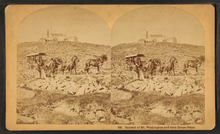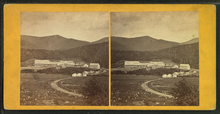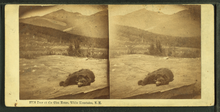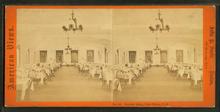Glen House

















Glen House was the name of a series of grand resorts, between 1852 and 1893, in Pinkham Notch very near Mount Washington in the White Mountains of New Hampshire, USA.
History
The completion of the Grand Trunk Railway in 1851 established a route from Portland, Maine, to Gorham, New Hampshire, and brought increased visitors to the area. John Bellows converted a farmhouse into a hotel the same year and then sold the hotel in April 1852 to J. M. Thompson, who renamed it the Glen House and finished work on its rooms.[1]
The hotel was expanded by 1866. Guests included Albert Bierstadt, and the Bierstadt Brothers captured stereoscopic photographs of scenery in the area including a bear. John P. Soule, G. W. Woodward, Nathan W. Pease, and the Kilburn Brothers also captured stereoscopic images from the area, including mountain landscapes and other scenery as well as some of the grand hotel and its interior spaces.
Albert Bierstadt discovered hotel proprietor Col. Joseph Mariner Thompson's body in 1869 down river from his sawmill following a heavy fall rainstorm . Ownership of the Glen House was then taken over by the Milliken brothers. It was completely destroyed by a fire in 1884. Rebuilt and expanded over the next few years, the hotel burned again in 1893 and was not rebuilt. Property ownership was acquired by the Libby family of Gorham who converted the servant's quarters into a 40-room hotel that was also destroyed by fire in 1924. In 1925 a smaller fourth Glen House was constructed now serving winter sports enthusiasts as well as summer travelers. In March of 1967, this Glen House also caught fire and burned to the ground. The fifth Glen House is under construction and due to open in the summer of 2018.[1]
The hotel featured views of Mount Washington, Tuckerman Ravine, and the northern Presidential Range. Guests could visit Mount Washington on the newly opened Carriage Road (now the Mount Washington Auto Road) to its summit, visit other natural attractions in the area, or recreate in the hotel's game rooms, parlors, library, listen to an orchestra, dance, play lawn tennis, fish, play croquet, hike, horseback ride, enjoy a guided carriage ride, or take in a theater show.[2][self-published source?]
A new Glen House hotel is scheduled to open at the base of the Mount Washington Auto Road in September 2018.[citation needed]
References
- ^ a b Glen House White Mountain History
- ^ Grand Hotels of New Hampshire New Hampshire Notes
44°17′20″N 71°13′27″W / 44.28889°N 71.22417°W
Further reading
- The Glen House Book by Charles Milliken (1889)
- The Grand Resort Hotels of the White Mountains by Bryant Tolles
